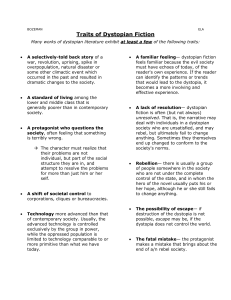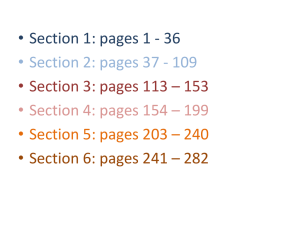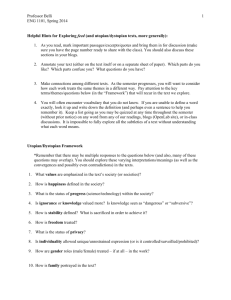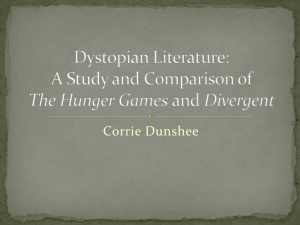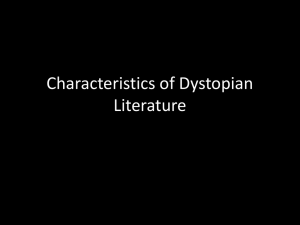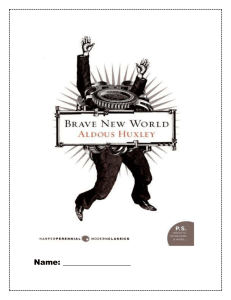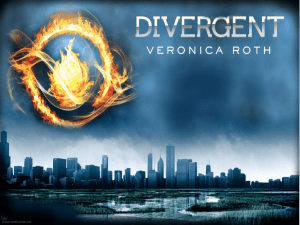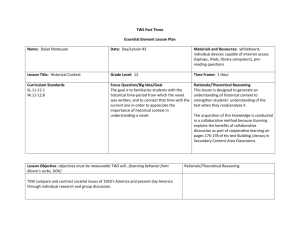Replace This Text With The Title Of Your Learning Experience
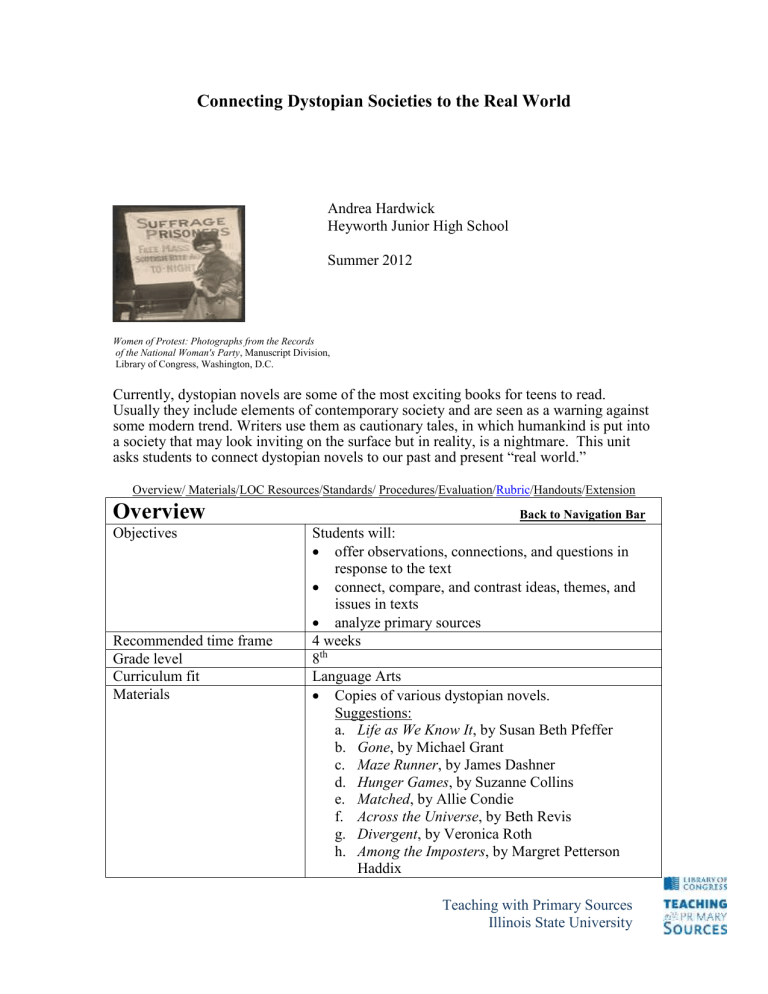
Connecting Dystopian Societies to the Real World
Andrea Hardwick
Heyworth Junior High School
Summer 2012
Women of Protest: Photographs from the Records
of the National Woman's Party , Manuscript Division,
Library of Congress, Washington, D.C.
Currently, dystopian novels are some of the most exciting books for teens to read.
Usually they include elements of contemporary society and are seen as a warning against some modern trend. Writers use them as cautionary tales, in which humankind is put into a society that may look inviting on the surface but in reality, is a nightmare. This unit asks students to connect dystopian novels to our past and present “real world.”
Overview/ Materials/LOC Resources/Standards/ Procedures/Evaluation/
Overview
Objectives
Recommended time frame
Grade level
Curriculum fit
Materials
Students will:
offer observations, connections, and questions in response to the text
connect, compare, and contrast ideas, themes, and issues in texts
analyze primary sources
4 weeks
8 th
Language Arts
Copies of various dystopian novels.
Suggestions: a.
Life as We Know It , by Susan Beth Pfeffer b.
Gone , by Michael Grant c.
Maze Runner , by James Dashner d.
Hunger Games , by Suzanne Collins e.
Matched , by Allie Condie f.
Across the Universe , by Beth Revis g.
Divergent , by Veronica Roth h.
Among the Imposters , by Margret Petterson
Haddix
Teaching with Primary Sources
Illinois State University
i.
Uglies , by Scott Westerfield j.
Unwind , by Neal Shusterman k.
Genesis , by Bernard Beckett l.
The Forest of Hands and Teeth , by Carrie Ryan m.
Ferhenhiet 451 , by Ray Bradbury
Print pictures and create a bag for each group.
Student Analysis Tool or online at:
Primary_Source_Analysis_Tool.pdf
Illinois State Learning Standards
Reading: Literature:
CC.8.RL.1.
Cite the textual evidence that most strongly supports an analysis of what the text says explicitly as well as inferences drawn from the text.
CC.8.RL.2.
Determine a theme or central idea of a text and analyze its development over the course of the text, including its relationship to the characters, setting, and plot; provide an objective summary of the text.
Writing
CC.8.W.2.
Write informative/explanatory texts to examine a topic and convey ideas, concepts, and information through the selection, organization, and analysis of relevant content.
Introduce a topic clearly, previewing what is to follow; organize ideas, concepts, and information into broader categories; include formatting (e.g., headings), graphics (e.g., charts, tables), and multimedia when useful to aiding comprehension.
Develop the topic with relevant, well-chosen facts, definitions, concrete details, quotations, or other information and examples.
Use appropriate and varied transitions to create cohesion and clarify the relationships among ideas and concepts.
Use precise language and domain-specific vocabulary to inform about or explain the topic.
Establish and maintain a formal style.
Provide a concluding statement or section that follows from and supports the information or explanation presented.
Procedures
Day One:
Journal: Is it possible to create a perfect world?
Teaching with Primary Sources
Illinois State University
How would you go about doing this?
Introduce- utopian/dystopian societies by having a class discussion and defining terms.
Each group is given a bag of photographs/ advertisements printed from the Library of Congress website.
Each person in the group chooses a picture/
advertisement and completes a student analysis sheet or online at:
Primary_Source_Analysis_Tool.pdf
on their picture/ advertisement.
Students come back to the group and discuss each picture analysis. Each group member needs to discuss and add to other group members findings.
The teacher will put five large post-its around the room and have each group write WHAT THEY
KNOW about the event in history to the sheet.
As a class, read and discuss each event.
Day Two:
BOOK PASS--- give each student two minutes to look at a book and take notes. Students will score the books on a 1-10 scale (10 most interested in reading). After scoring the book, they will explain their reason for the rating.
The teacher selects the book club books, and students begin reading.
Day Three- (groups will move at different speeds):
While they are reading, they will keep a literature response journal. While journaling, students will list:
the positive aspects of the society and
what had to be given up to create this society?
Students will set up meeting times throughout their reading to discuss.
Days Four-Thirteen:
Students continue to read the assigned book and meet with peers for discussion
Day Fourteen--when students finish reading:
When they finish the book, they will write an informational paper and create a propaganda
advertisement. See the Handouts for specific
requirements.
Teaching with Primary Sources
Illinois State University
Evaluation
Students will be evaluated on:
the connections they make in their final essay using
how well they convey a social theme or message in
their advertisement using the rubric
Extension
Have students view a movie that deals with dystopian themes or subjects, and write a review comparing and contrasting it to their novel.
Choose a song with a dystopian theme that best fits their book and analyze the lyrics to explain why this song would be perfect for their book.
Teaching with Primary Sources
Illinois State University
Primary Resources from the Library of Congress
Image Description
Freedom of expression, of religion, from want, from fear everywhere in the world
URL
Library of Congress
Prints and
Photographs Division
Reproduction number:
LC-USZC2-5436
DLC (color film copy slide)
Citation
http://memory.loc.go
v/cgibin/query/r?ammem/ wpapos:@field(NUM
BER+@band(cph+3f
05436))
A complete list of stamp duties, to take effect August 1, 1864.
Library of Congress,
Rare Book and
Special Collections
Division http://memory.loc.go
v/cgibin/query/r?ammem/r bpebib:@field(NUM
BER+@band(rbpe+0
7106500))
The Sioux War - cavalry charge of
Sully's brigade at the
Battle of White Stone
Hill
Illustrations of the
American anti-slavery almanac for 1840.
Western
History/Genealogy
Department, Denver
Public Library
September 3, 1863.
Library of Congress,
Rare Book and
Special Collections
Division http://memory.loc.go
v/cgibin/query/r?ammem/h awp:@field(NUMBE
R+@band(codhawp+
10033777)) http://memory.loc.go
v/cgibin/query/r?ammem/r bpebib:@field(NUM
BER+@band(rbpe+2
4800100))
Lucy Branham on
Prison Special
Women of Protest:
Photographs from the
Records of the
National Woman's
Party , Manuscript
Division, Library of
Congress,
Washington, D.C. http://memory.loc.go
v/cgibin/query/r?ammem/ mnwp:@field(DOCI
D+@lit(mnwp000250
))
Teaching with Primary Sources
Illinois State University
Poster for Thirteenth
Naval District, United
States Navy
Library of Congress,
Prints and
Photographs
Division, WPA
Poster Collection,
Rreproduction number, LC-USZC2-
985 DLC http://memory.loc.go
v/cgibin/query/r?ammem/ wpapos:@field(NUM
BER+@band(cph+3b
48885))
Teaching with Primary Sources
Illinois State University
Rubric
Dystopian Essay Rubric
1.
Focus: There is a clearly-worded thesis statement which incorporates the topic, stance, and plan you intend for your essay. Your paper has a clear and appropriate focus. Your topic offers insightful and in-depth analysis of your topic.
Exceptional—strong—capable—developing
2.
Organization: You divide your argument into coherent, logical categories, and appropriate headings. You transition between these categories and show the relationship of ideas. You also transition and show connections between ideas and research so that the reader understands how relates.
Exceptional—strong—capable—developing
3.
Support: You have sufficiently supported your thesis with specific examples from the novel and possibly other outside sources. Your evidence is credible (e.g., you’ve established its credibility and it comes from respected, relevant sources). You’ve connected evidence from your reading to your original ideas/insights so that the source material serves as proof of your thesis/topic sentence
Exceptional—strong—capable—developing
4.
Paragraph Focus: Each paragraph is carefully focused on one particular aspect of your topic. This focus is clearly indicated, and the relationship between paragraphs is made clear. There is a clearly-worded topic sentence to indicate the focus of the paragraph?
Exceptional—strong—capable—developing
5.
Introduction/Conclusion: You effectively introduce your topic. You’ve used a method of introduction that captures the reader’s attention. Your conclusion restates your thesis in a manner that does not feel repetitive. You use a method of conclusion that does more than simply restate the main ideas; it engages the reader’s emotions, or provides an application to society, etc.
Exceptional—strong—capable—developing
6.
MLA: In-text documentation. You correctly document sources’ and ideas, use correct punctuation, and handle long quotes correctly.
Exceptional—strong—capable—developing
7.
Basic Writing Conventions: You following standard writing conventions of grammar, spelling, and mechanics.
Exceptional—strong—capable—developing
Comments:
Teaching with Primary Sources
Illinois State University
Dystopian Propaganda Poster Rubric
You will be graded on the quality of the following ideas:
1.
Theme- Determine the theme or central idea of the text, and analyze its development over the course of the text, including its relationship to the characters, setting, and plot.
Have you chosen a theme that reflects a social issue in the novel?
2.
Slogan- Your slogan needs to creatively address a social issue as well as persuade us that it’s “best” for the people.
3.
Images and symbols- Images and symbols are used to represent the theme of the novel. Present claims and findings, emphasizing salient points in a focused, coherent manner with relevant evidence, sound reasoning, and wellchosen details.
Use images to connect to your novel.
How well does the artwork demonstrate an understanding of the dystopian society you read about?
4.
Persuasive qualities- Images and words should persuade, through argument, national loyalty, interest, or emotional quality.
Exceptional—strong—capable—developing
Comments:
Standards: Determine the theme or central idea of the text, and analyze its development over the course of the text, including its relationship to the characters, setting, and plot.
Present claims and findings, emphasizing salient points in a focused, coherent manner with relevant evidence, sound reasoning, and well-chosen details.
Teaching with Primary Sources
Illinois State University
Handouts
Dystopian Societies Novel Study
After reading your novel, write one of the three essays and create a propaganda advertisement.
Essay 1:
Write a character analysis of the protagonist (main character) in your story that includes the following information: the character's appearance, actions, ideas (what the character thinks), manner (how the character acts), reactions of others to the character, and feelings of the character throughout the course of the novel. a. Do the character's feelings/ideals change? b. Why is he/she important to the novel? c. Would you like this character if you met him or her? Explain. d. Would you like to be this character? Explain. e. How well does/would your character fit into a dystopian society? f. How well would he or she fit into our society?
Essay 2:
What message did you get from this book? What point was the author making about dystopian societies? Do you think the author was successful in getting the message across? Why? What were the good and bad points about this novel? How realistic is this novel so far as its use of the dystopian concept? Make any additional comments you'd like reflecting your reaction to the novel as a whole and its relationship to our society today, our history, and a dystopia.
Essay 3:
Chose an event in history and compare/ contrast the dystopia to your chosen event in history. Discuss what events are similar and different. Historically, as a society, what did we learn? How could the dystopian society learn from the lessons of our past? How would the protagonist fare in the chosen event in history? What strengths would he/ she have? What struggles would he/ she face? Make any additional comments you would like as you reflect on the novel and its relationship to our society’s history.
Advertisement:
Teaching with Primary Sources
Illinois State University
Based on the analyzing propaganda advertisement analysis your group filled out at the beginning of the unit of study; use your dystopian society novel to create a propaganda advertisement produced by the “government.” Think about what message the
“government” might want to get across to the people. What are they covering up? What are they controlling? What sacrifices are the people forced to face? How can the government put a positive spin on things?
For example: How can the government, in Matched make people believe it’s ok to kill the elderly? How can the government, in Divergent , make people choose one fraction or another? In Hunger Games , why is it ok for the districts to send two kids to fight to the death? In Across the Universe , how can drugging the drinking water be ok? These are just a few obvious examples from a few of the books.
Reflect on your book and create a propaganda advertisement.
.
Teaching with Primary Sources
Illinois State University
